Yondee Shane Hansen Artist Profile – Noongar Aboriginal Art
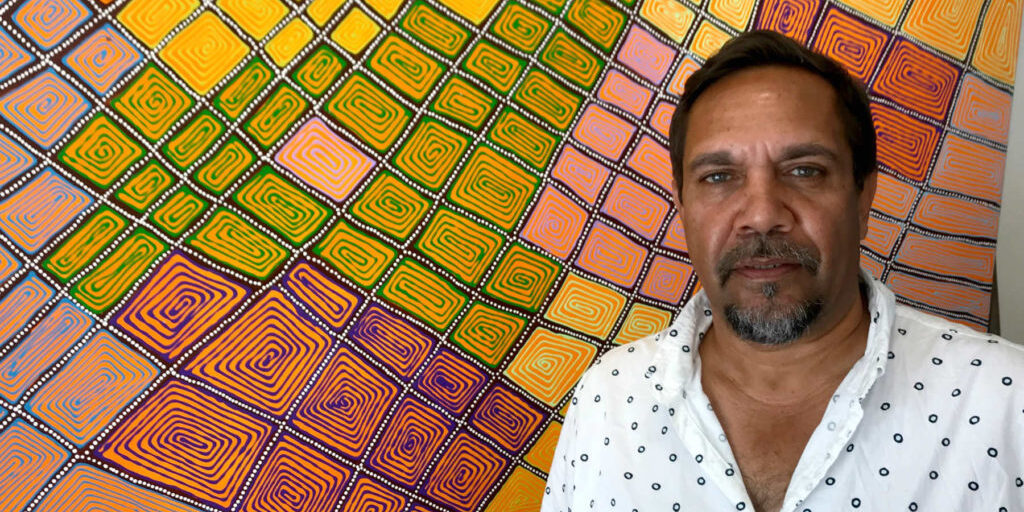
This artist profile interview presents Noongar artist Yondee Shane Hansen, discussing his art, traditional Dreaming stories and Noongar history.
My Art
Charcoal & Ochre
My art story starts as a child. We'd find grey logs that had fallen on the ground. They were really nice and smooth. Sitting around the fires, we kids would pick up the charcoal and draw along those grey logs. We'd draw symbols of kangaroos and emu tracks. I went from that to painting with ochres. At that time Aboriginal art was mostly recognised as either ochres or dot paintings. The first works of mine that appeared in galleries were painted in ochres.
Straight Lines
A lot of my line work has always been a consistent part of my art. I like clear, straight lines that give definition. It gives strength and it creates my own identity in the art world as a traditional Whadjuk Ballardong Aboriginal artist.
Black & White
Painting in black and white goes back through my art history and continues today. Black and white works don't age with time. They just keep getting better and better. A lot of people choose art that suits the way they've set up their homes. Black and white art can be used in a modern contemporary style of living, it can be used in an older style housing living. So it's got the unique ability to work in the past, it can work in the present, and it can continue to work in the future. I think that's why black and white paintings are really popular. They are timeless.
The Seasons
I enjoy painting the seasons. People who aren't visually or spiritually connected to those seasons can find connection through the paintings. What I'm trying to do is not only look at how the seasons are rotating and how they're moving through the Noongar seasons.
Colour
I'm bringing together my use of lines and exploring strong colours. I'm aware of how other styles have evolved in northern parts of Australia. It's important to me that my art is distinctive and different. Those lines and vibrant colours, they're connected to the style of art that I do down here in the south of Western Australia.
There's been an explosion in my use of colour over the last couple of years with the Derbarl Yerrigan. The reason why we've used the colours is to try to incorporate all the six seasons together onto one canvas. I'm saying we, because I'm increasingly working closely with my wife Bridget.
View: Yondee Shane Hansen Artwork

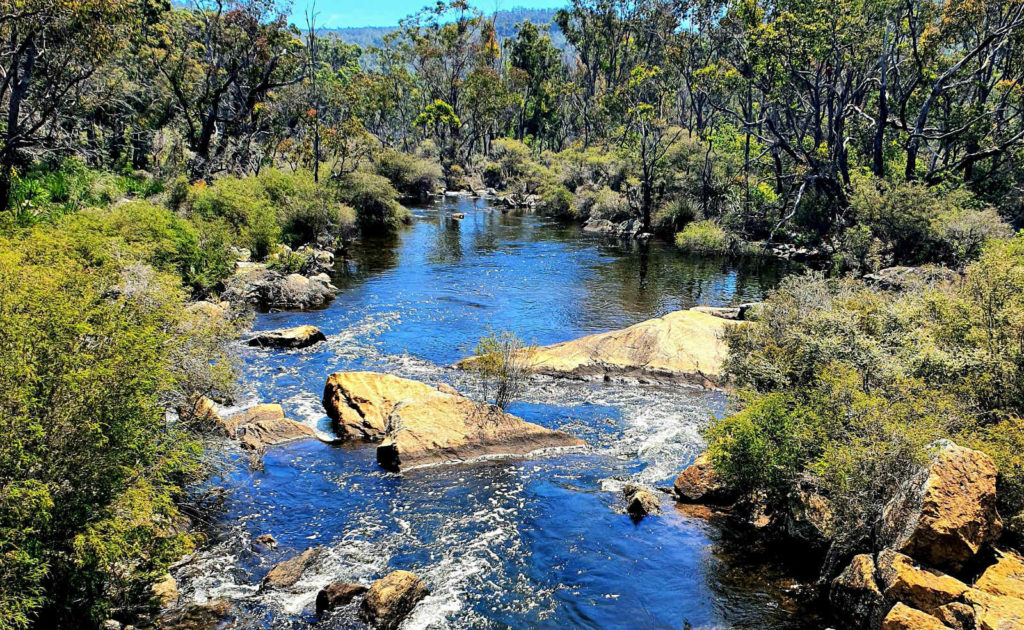
Derbarl Yerrigan
Now down here in the south of Western Australia, in Perth, we have a large river which is called Derbarl Yerrigan, or the Swan River. I noticed as I started to paint, that no one was recording the Derbarl Yerrigan as a story that travels through that country and through the Whadjuk nation. It's where the Wardal travelled through and created the rivers.
Traditional Story of the Swan River
So we wanted to record something that no one else was doing. We wanted to do it because it is an important location that people had overlooked. It's just the Swan River, but it's much more to us than that. How do we create it in such a way that it tells a good story to people from around the world to say, "Yes, the Noongar people are still connecting to their country, still connecting to their Dreamings, and still maintaining the stories about our culture."? So we're pretty proud and I'm very happy. Bridget has come on board and we developed a really good sense of balance of colour in how that story is presented.
Points of Difference
We try to make it so that each design has something different going on. It could be just a different colour that people need to look for and find. We use a lot of purple tones because they can be strong spiritual colours. We want people to be able to take the art away and enjoy it in such a way it becomes part of their family, it becomes part of their household and it becomes part of their story.
Exhibition in Switzerland
Around 2002 I had an exhibition in Switzerland. In that show I had works painted with sand. I flew over for the opening of the show. The sand I used is from the river. We call it the Spirit of the Land. We take the river sand, wash it and clean it and sieve it, and then we mix it in with some binding medium. Then we put it all together and we put it on the canvas. We've had some really good responses. White on white. There's one I've done with the Rain Man. That one I've been painting for about 25 years. Some of the paintings I've been painting, like the emu feathers, I've been painting that constantly for many years.
Chasing The Light
One of the things I like to chase is light. I like to chase and introduce natural elements that are sometimes invisible. Many of these elements are there all the time. I needed to understand the scientific as well as the spiritual connection behind it. You've got to understand the rotation of the sun is around the earth, when is the best time for the sun to be able to hit the canvas and create shade and shadow.
How Movement Helps People Connect To Art
Sometimes my work has movement in it and that's when I'm trying to capture the sense of the wind. When you stare at it, you sit up there, it actually starts to flicker and move. It's important to let people take a journey through colour, through movement, through shadow. So that's what we try to do is to get them involved, get them talking. There's something going on and they don't know until eventually after many years they start to look and go, "I'm spiritually connected to some of the stories."
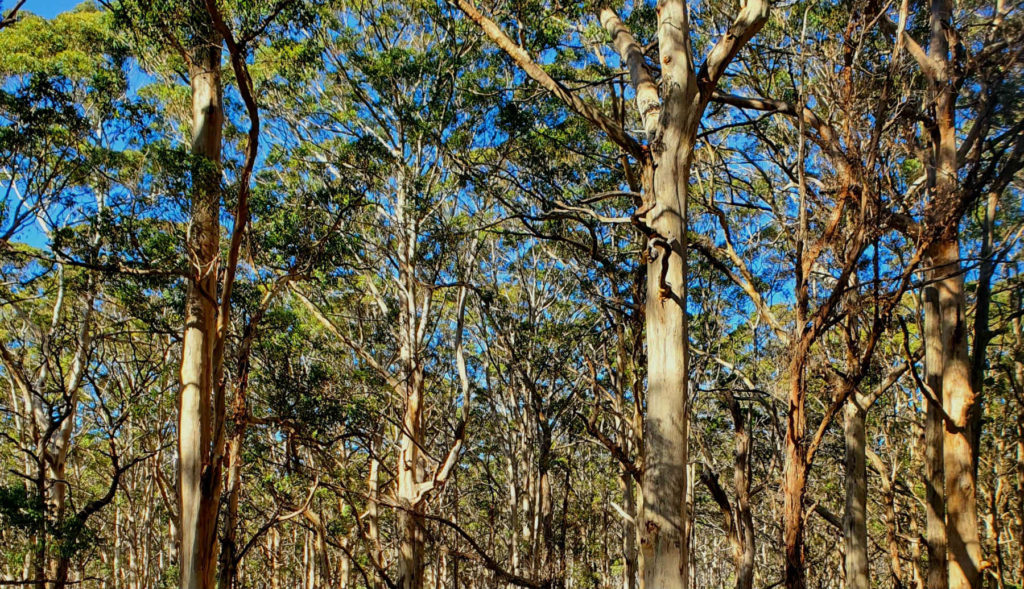
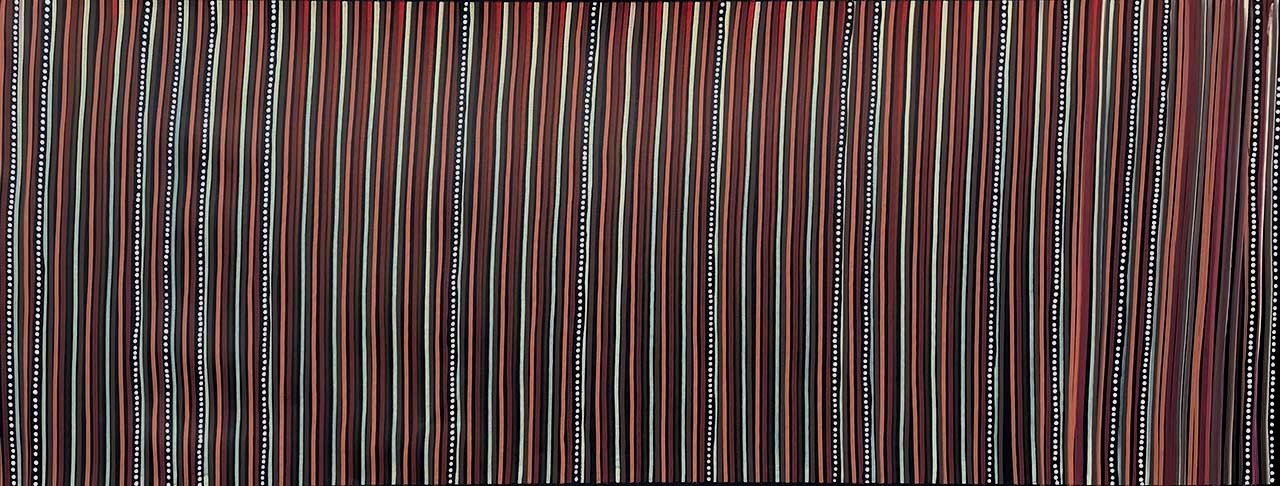
My Stories
Rottnest Island Connection
We've done two workshops now with all the elders of the Whadjuk and the Ballardong Nation here at Perth. The name for Rottnest Island in the Noongar language is Wadjemup. All those elders are by connection to my bloodline. So I have a direct connection to some of the cultural story that's been shared here in the Perth area. I also have a connection with Wadjemup. We've just done it around a cultural workshop with the traditional owners and my blood family from Wadjemup. We were building our understanding of the story, how the story evolved from Wadjemup with the story of sadness, and also the story of how the people of the Whadjuk nation were there on the island before it became a prison camp. They were there thousands of years before any ships came through.
Recording Traditional Dreaming Stories
During the workshops, we recorded the stories through visual art. We put the words into the visual, the artworks. That was well-received within the Noongar cultural centres here at Perth. But the interesting thing we found is as the seas were rising and the lands around Wadjemup, Carnac Island and all the islands out there, the Aboriginal people, my people, were starting to move more back inland. They were actually still able to learn how to adapt to change, how to read the land and still make connections through the Coral reef Dreaming, Inland Dreaming, Salt Water Dreaming, and it still has been a major part in our identity here as the Whadjuk nation.
Cultural Mapping With University of Western Australia
The other project we've done is participate in a cultural mapping project at the University of Western Australia. That involved recording, restoring and connecting the storylines through art. We were well received by the university.
Rottnest Museum
I was involved in the museum over there by putting together a scope of work. I had to ask myself: do you cross the border of political correctness or do you stay conservative and keep a peaceful approach? That was the issue I was confronting because my emotions and my spiritual vibrations were clashing, and I had to find balance in my own approach to the project on Wadjemup. Did I want to feel the pain? Did I want to feel the anger? Did I just want to tell a story that can be there for hundreds of years?
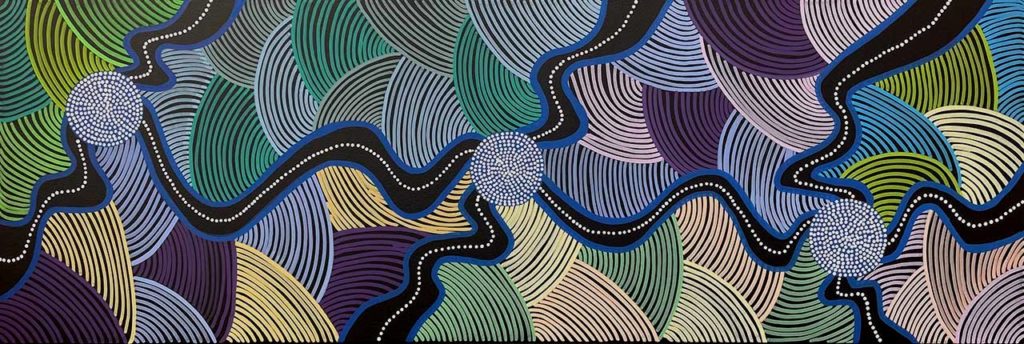
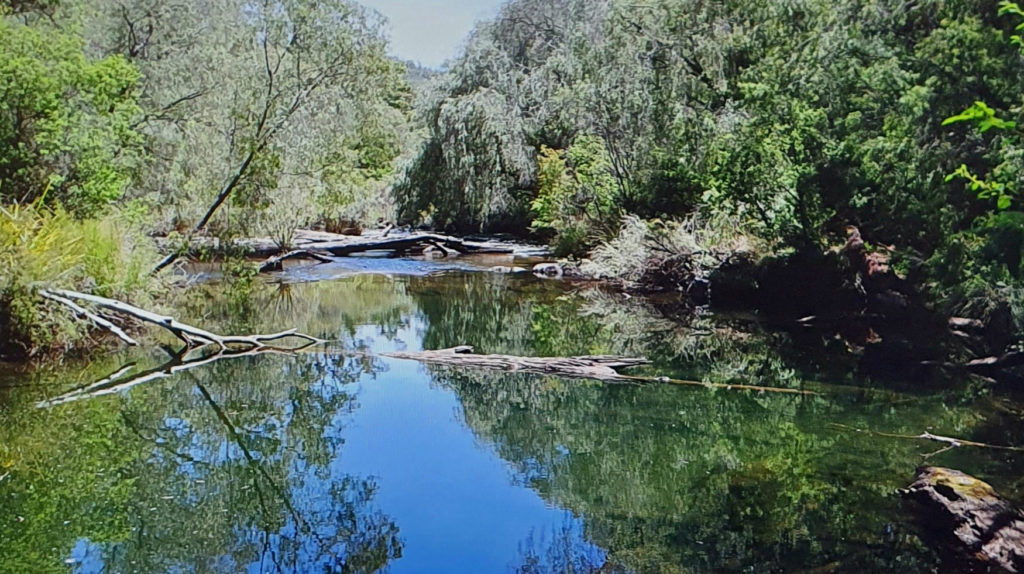
The Bolt of Lightning Story
Eventually, I told the story about the bolt of lightning hitting the ground, creating fire and then the rain and the fire came from one connection with a bolt of lightning. As the bolt of lightning hits the ground, the fire travels through the ground, and then as the bolt of lightning goes back in the sky, it's connected to rain or water. From the two elements there comes one energy, which is the bolt of lightning. The only time the sky ever touches the ground is when the bolt of lightning connects to the ground and then is still in the sky. So the story I told on Wadjemup was that the land was always able to take care of itself before the first man or woman was ever born. Our people, my people, the Aboriginal people came along and we mastered the technique and harnessed fire, we respected water. And so that was the story I wanted to be able to share with people. I know there's the dark side of it, but as an artist we try to tell a story that's still true, but we add another approach.
When I've met with the committee to find the solution about telling a story based on Aboriginal people, the best work presented was through a bolt of lightning creating and healing the land, and vice versa. The fire and the water, they both have the same energies and the same power. Fire can cleanse and the water can heal, and then you can have it the other way around. The water could cleanse and the fire can heal. But the two are the same. That was the story I put on a placard on Rottnest Island in the upgrade of the museum, which has also just been opened to the general public.
South Perth Project
We did a project at South Perth, which was Karl Kep water and fire down in the South Perth Foreshore. It's a permanent structure - very prominent in its space where people could come from around the world to visit it. It's a light show and a sound show. I designed the artwork for that and put it together. We won two awards for that particular space. One is a Western Australia Tourism Award, and the other is the Australian Gold Art Award. I'm never big on awards, I don't even keep a record of any of my achievements because I think that the art, it's just a piece of paper in the end, but some people like it.
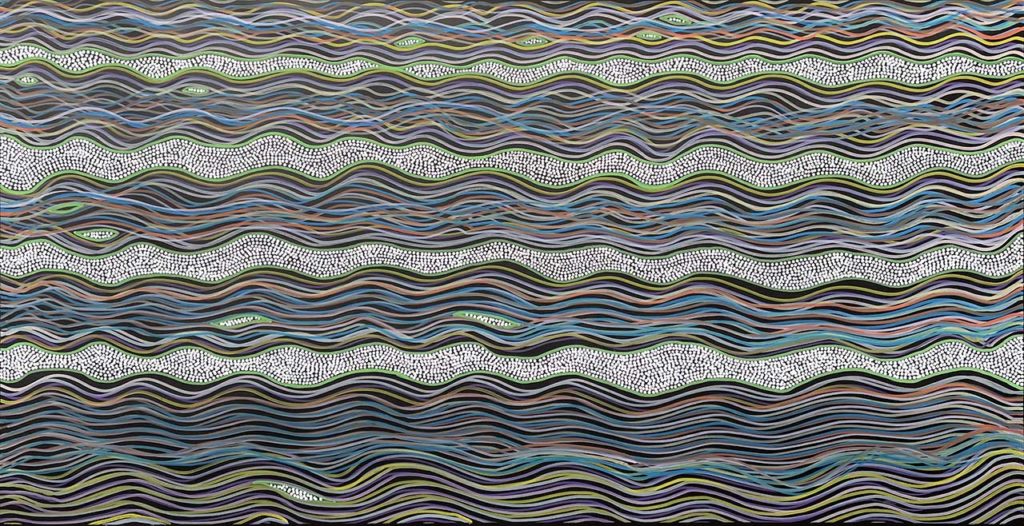
Our History
The Noongar People
The Noongar People are starting to slowly regenerate, reconnect to the country and their ancestors. I had an experience when I was in Sydney about 20 years ago down at Circular Quay. I was carrying four canvases on my shoulder. I had someone come up to me and they said, "What have you got?" I said, "I’ve got some paintings, Aboriginal partings." He asked, "Why do Aboriginal people think their culture still exists in cities?"
I said, "Well, what's the energy you're feeling right now? Well, that's wind. That wind has been blowing through my ancestor's hair for thousands of years. You see the sun that's shining down on your skin? That sun has been shining on my forefather's skin for hundreds of thousands of years. I know our culture still exists. It exists in the city, it exists in the urban area, it exists in the bush. Nothing changes because the natural environment is ever-present. The elements like the moon and the stars, the sun, the rivers, the water, it's always there. If that's always there our culture is always going to be there, because that's who we identify with. We don't identify with modern contemporary structures that are here for five years, we connect to things that have been here hundreds of thousands of years, which will never be taken away. One thing life will guarantee is the moon is always going to be there, the sun is always going to shine, and the stars are always going to be in the night, and that's one I can guarantee.
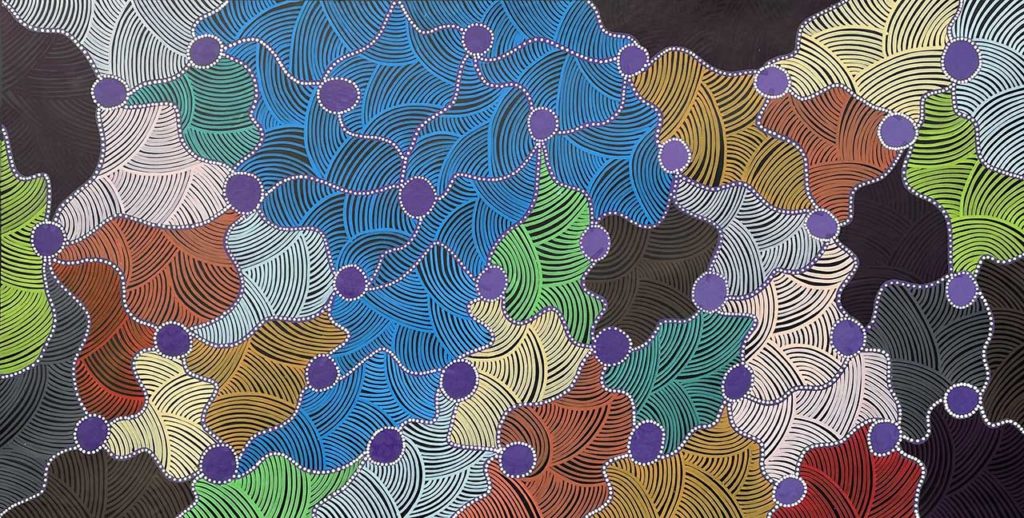
Gnamma Holes
A lot of the paintings I do have been connected through my bloodline, through my grandfather and my mother's bloodline and family, many generations talking about these Gnamma holes, which were especially important to the Aboriginal people to store and capture and trap water during the summer months. I wanted to be able to bring that to a canvas. A lot of my stuff is if I see something missing, I want to paint it because it keeps it alive. It preserves the story, the original purpose.
The old people made these Gnamma holes, they are not just a tourist spot. They're actually still recorded as Aboriginal sites that have been created over hundreds and hundreds of years to store and preserve water. This particular Gnamma hole is important because the Aboriginal people not only took care of themselves but they also took care of nature. So when they've made these Gnamma holes, they were probably somewhere 30 centimetres across and probably a metre to a metre and a half deep.
They used to put a stick in the middle of the Gnamma holes. So if there's ants or a small marsupial fell into the water hole, this stick, they can actually climb up the stick and get out. All those indicators to me are important because even though everything was there around the Gnamma holes, they still made sure that all the ants had access to drink the water to share it from the one hole. Gnamma Holes, that's one of my paintings that we create through a lot of the colour range with the blues and the purples and the vibrant colours.
Noongar Seasons
So the Noongar seasons have been well introduced, it started to be taught in schools. If you understand the seasons then you can understand yourself and your environment, because you can actually see physically through your own eyes how much you start to see the indicators, like the trees will start to blossom. Traditionally these seasonal indicators told my people when fish would be travelling through the Derbarl Yerrigan.
View: Yondee Shane Hansen Artwork
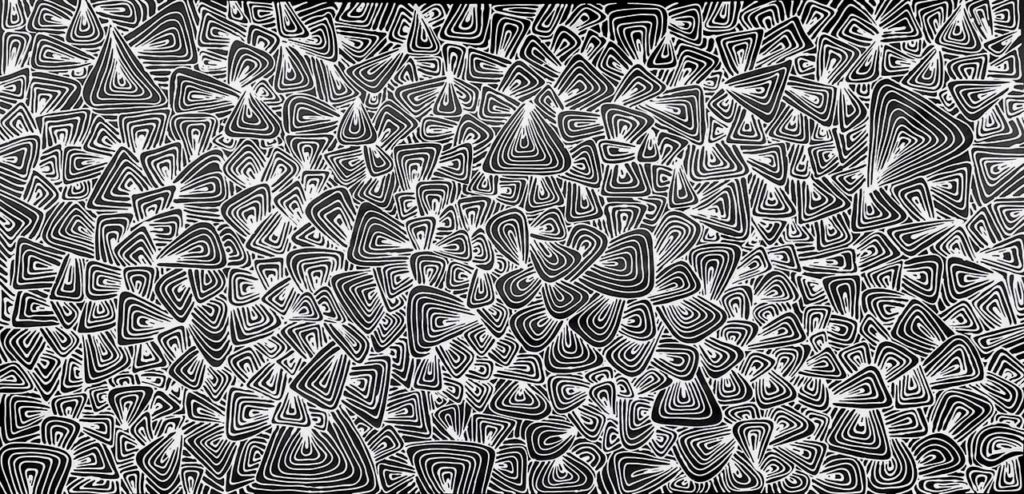
Shell Middens
Anthropologists and archaeologists are keen to understand the coastal living of Aboriginal people. They always search for shell life or shellfish because this helps them with carbon dating. We focused on the shell middens, which a lot of the Whadjuk people have eaten along the river systems and the coast systems. Briget knows that cultural story, she was able to assist with that during our participation in the cultural mapping project.
The Rain Man
The Rain Man is a bolt of lightning, which is the symbol of water and fire. I just wanted to create it all in blues. So I created all different shades of blue with the Rain Man, with the bolt of lightning around him, with his spear. I had the thought because this image doesn't come together overnight. It's a process. It's a process of being in your head, visualising it in your head, to make sure the balance of colour, the figure is right, the shape is right and the story is strong. That's how I was able to make sure that it's a powerful image. It's a very spiritual image, and people connect to it because it's a thing about regrowth.
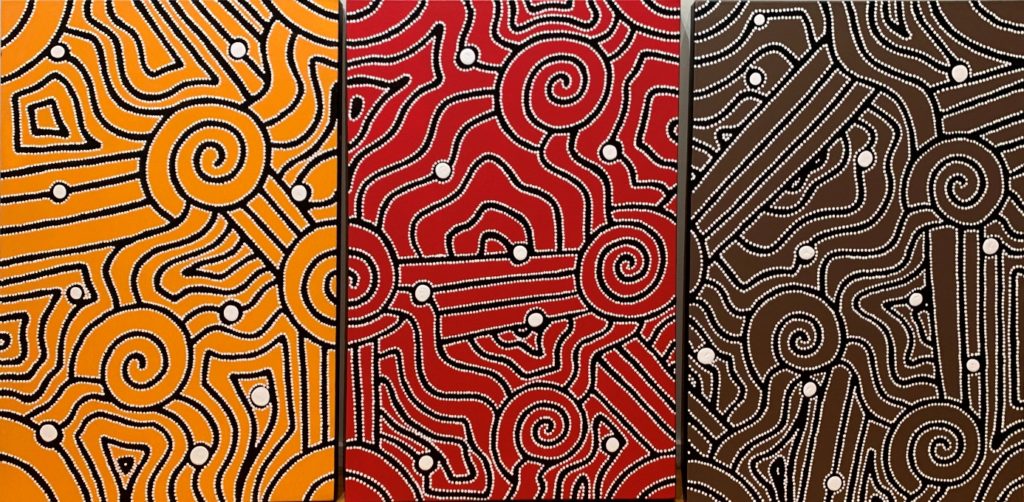
Connection to The Earth
There's two things, there's physical homelessness and spiritual homelessness. No matter how many buildings and how many roads they decide to put over the land, people are still going to be spiritually connected to that piece of country. It could be a concrete slab, but people go there and see it because there's something that's pulling them there to say, "Sit here." You'll see animals cross paths on their lines too because they feel the vibration. It's like ants. Ants pick up the vibration in the land, and they actually start to pick up the vibrations. They help each other in a community sense.Everything is by instinct. If there's a little seed of grass, a small seed of a grain of sand, then that energy creates the vibration that cracks through the ground. As it cracks through the ground there's a vibration going through and the ants can actually feel the vibration just from that one seed coming up. And they know exactly, "Okay."
So they're in tune with Mother Earth. They're actually in tune with each other. The vibration in the ground is always there. And then we go onto the other part of that is spiritual healing. Mother Earth's advice and her wisdom is that if you do not connect with your surroundings, then you will be having anxieties. My way of thinking, anxiety is created by people that are playing an instrument that is out of tune.
So if you're playing a guitar and you haven't fine tuned that guitar, then it doesn't make sense. But if you sit down, you take time to meditate on that guitar and you tune it, it sounds beautiful. It's the same as Mother Earth. If you take time and sit down and connect with her, she'll give you all that vibration, she'll take away all those anxieties and say "Come sit and weep." You understand her voice, you understand her vibration. You learn to slow down your breathing, you learn to listen to the wind, listen to the stories and listen to nature. That's all part of that fine tuning.
Putting The Spirit Back In
Someone said to me, "Oh, how do you feel about working with contemporary stuff like concrete and steel, and whatever?" I said, "It all comes from Mother Earth." I said, "Concrete didn't fall out of the sky." I said, "It came from the ground, went through a process."
Industrial manufacturing takes the spirit out of the land. It took the spirit and just made it a concrete slab. But I still like the idea of working with it because for me working with it, I can actually put the spirit back into it. I think about processed food in a tin. If you take food and you put it in a factory, and then into a tin it actually takes out all its nutrients because it disconnects from the natural origins. That tin might have been made in England or China or Japan, it gets to Australia, it's half the food it once was. The spirit of the food has left, so you only just left with something that feels lifeless, lacking in spirit.
My Experience of the Art World
Art is a way to bring the spirit back in our lives. It can connect and replenish through the stories. In the art world I've connected with amazing people. I've never found the world of art to be anything but amazing. It is full of knowledge, caring and loving. It takes me on amazing journeys.
